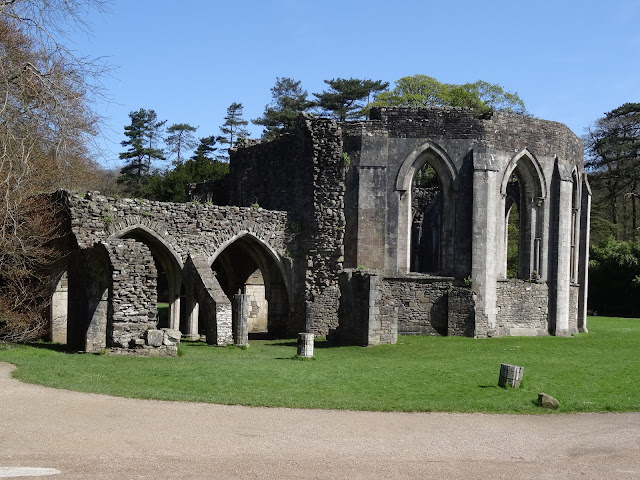Inside it is big boned; there is a satisfying solidity and strength to the austere Norman architecture. It is very Cistercian in that respect. Atmospheric too with the nave dark and mysterious, the aisles bright with spring sunshine. If there is one, only one, criticism it is the low, heavy ceiling. But that is a minor quibble for the church is filled with good things - in particular the the remarkable collections of funerary monuments in both aisles; Talbots to the North and Mansells to the south with a proper nestling of Jacobean alabaster tombs commemorating four generations of the family. For me perhaps the most interesting monument is that to Theodore Talbot, based on the tomb of Archbishop Grey in York Minster. It is rather large, possibly over-scaled, but it adds a welcome element of spatial complexity to the Talbot chapel.
Through the small door in the south aisle and into another world: Margam Park. (I don't think we should really have done that but got back into the car and driven round to the official carpark.) Perhaps an unexpected one at that, for who nowadays associates industrial south Wales with landscaped country parks. However Margam is not alone, just outside Neath, only a few miles up the M4 from Margam, stands the Gnoll estate. And like Margam, Gnoll is owned by the local council. Anyway the door opens to where once were the cloisters stood and is now a woodland garden with beautiful specimen trees. To the left the remains of the east range of the cloisters - a kind of gothic skeleton, all the walls having been removed just leaving the piers and the vaults, and looking like an illustration in an 18th century Gothic novel. Also surviving is the polygonal chapter house, alas without its vault. Polygonal chapter houses are a bit of a British speciality; Margam is the only one in Wales, but there are three in Scotland and seventeen in England not counting the Norman circular one at Worcester, where the idea probably originated. Ahead is the site of the great house built by the Mansells and incorporating parts of the abbatial buildings.
Through the small door in the south aisle and into another world: Margam Park. (I don't think we should really have done that but got back into the car and driven round to the official carpark.) Perhaps an unexpected one at that, for who nowadays associates industrial south Wales with landscaped country parks. However Margam is not alone, just outside Neath, only a few miles up the M4 from Margam, stands the Gnoll estate. And like Margam, Gnoll is owned by the local council. Anyway the door opens to where once were the cloisters stood and is now a woodland garden with beautiful specimen trees. To the left the remains of the east range of the cloisters - a kind of gothic skeleton, all the walls having been removed just leaving the piers and the vaults, and looking like an illustration in an 18th century Gothic novel. Also surviving is the polygonal chapter house, alas without its vault. Polygonal chapter houses are a bit of a British speciality; Margam is the only one in Wales, but there are three in Scotland and seventeen in England not counting the Norman circular one at Worcester, where the idea probably originated. Ahead is the site of the great house built by the Mansells and incorporating parts of the abbatial buildings.
However in 1782 the house was demolished and a spectacular orangery constructed (1787) in its place. It is the longest in Britain, and is the work of Anthony Keck (1726-1797). One part of the original Elizabethan/Jacobean house however was reused as a garden feature. Oddly it wasn't until the 1830s that a new house, 'Margam Castle', was erected to the designs of Edward Hopper (1776-1856) further up the hill and linked to the church and orangery by a majestic staircase, a thoroughly Baroque concept that wouldn't be out of place in Sixtine Rome. A nineteenth century equivalent, if you will, to the great cascade at Chatsworth. The house has the most wilful detailing and is a sort of compendium of early Tudor houses such as Hengrave Hall in Suffolk and Melbury in Dorset. Eccentric, ostentatious and oddly endearing. The family lived there until 1942.

























No comments:
Post a Comment